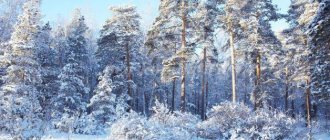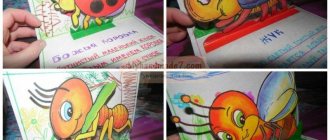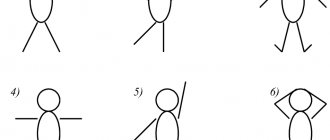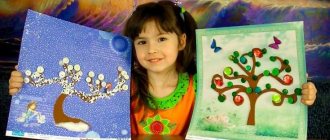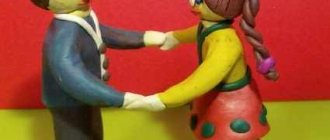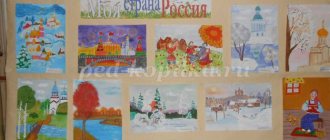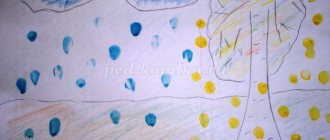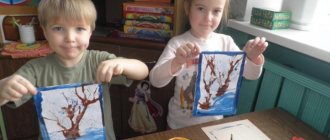Khokhloma. Khokhloma painting for children.
Khokhloma is an ancient Russian folk craft, born in the 17th century in the Nizhny Novgorod region. An old legend tells: once upon a time there lived a man in the Nizhny Novgorod forests, on the banks of a quiet river. We don’t know who he is or where he came from. The man carved wooden cups and spoons and painted them so that they seemed to be made of pure gold. The king found out about this and became angry: “Why don’t I have such a master in my palace?! Give it to me! Immediately!" He tapped his staff, stamped his foot, and sent soldiers to take the craftsman to the palace. The soldiers set off to carry out the royal order, but no matter how much they searched, they could not find the master’s miracle. He went to God knows where, but first he taught local peasants how to make gold utensils. In every hut cups and spoons sparkled with gold.
The village of Khokhloma, Koverninsky district, Nizhny Novgorod region, is considered the birthplace of Khokhloma.
Products for Khokhloma painting, most often dishes and furniture, are made of wood. But before painting on them, the surface is coated with a primer and shiny oil using a special technology. Then this shiny surface is tinned - aluminum powder is rubbed into it with a soft cloth, from which it becomes silvery and very smooth, and after varnishing - golden. The dishes are painted “Khokhloma” with oil paints. Traditional elements of Khokhloma are red juicy rowan and strawberries, flowers and branches. Birds, fish and animals are also often found.
Red, black, gold and green are the colors of Khokhloma. To liven up the pattern, a little white is allowed.
Painting can be “top” - a design is applied to a silver blank in red and black; and “under the background” - first the outline of the ornament is outlined, and then the background is filled with black paint, while the pattern itself is not painted, but remains silver. When varnished, the silver coating will turn golden and look as if it was made of gold. 
Let's practice horse Khokhloma painting? To do this, you need to print a sheet with the pattern or utensils you like. And there - pick up a brush and paints and go!
Grass is a pattern of large and small blades of grass. Pattern elements: sedges, blades of grass, droplets, tendrils, curls and bushes.
Herbal ornament.
Leaf pattern - stems and leaves.
The berry pattern includes the following ornaments: lingonberry, gooseberry, currant, strawberry, rowan, raspberry.
The “gingerbread” ornament is usually painted inside a cup or dish; it is a geometric figure (square or rhombus) decorated with grass, berries, and flowers.
In painting “under the background” the element “curl” is more often used. Curl painting is a rich, lush pattern with round, intricate curls reminiscent of curls. It is not the patterns themselves that are drawn, but the dark background. And the resulting pattern is supplemented with small colored elements (postscripts). This process is much more labor-intensive than horse painting.
Painted items are coated with a special varnish 4-5 times (with intermediate drying after each layer) and finally hardened for 3-4 hours in an oven at a temperature of +150 +160 °C until a golden-colored oil-varnish film is formed. This is how the famous “golden Khokhloma” is obtained.
Tasks.Continue to introduce children to different types of folk arts and crafts. Learn to notice artistic elements that determine the specifics of “golden Khokhloma”: the purpose of objects, material, manufacturing technology (in the most general terms, accessible to children), color, pattern. Learn to draw patterns on paper from plant elements (grass, Kudrina, berries, flowers) based on Khokhloma painting, use decorative elements when designing homemade books. Develop technical skills - skillfully use a brush (paint with the tip of the brush, with the whole brush, move freely in different directions). To cultivate an aesthetic attitude towards everyday culture and objects of art.
Preliminary work.
Acquaintance with folk arts and crafts, conversation about traditional crafts. Excursion to a folk art museum or a local history museum (with a teacher, art historian or with parents on weekends.) Organization in kindergarten of a mini-museum or “museum in a suitcase” (“in a chest”), the exhibits of which can be antiques and folk decorative items -applied art brought by parents for temporary exhibition.
Preparation of “books” for illustration by children in three subsequent drawing classes. The teacher carries out this work himself or together with the children in independent artistic activities. The book is made as follows: two sheets of white paper are folded in half, one is inserted into the other and fastened with a stapler or sewn with a needle and thread.
Materials, tools, equipment.
Album for children's creativity "Golden Khokhloma", a guide to familiarize yourself with the characteristic elements and color combinations of different types of folk arts and crafts.
Contents of the lesson.
Before class, the teacher displays objects with Khokhloma painting on the table or on a large stand and invites the children to admire them.
An approximate story from a teacher “Golden Khokhloma”.
— The village of Khokhloma, Nizhny Novgorod region, where fairs selling wooden utensils and painted spoons have been held since ancient times, gave its name to a whole craft that is now widely known in our country and abroad. The village is called Khokhloma, and the dishes that are made here are also called “Khokhloma”. For many, many years, craftsmen here have been making wooden ladles, supplies (suppliers), bratins, spoons... Nowadays, craftsmen have learned to make modern sets of dishes - for juices, ice cream, jam, salads, etc., as well as decorative dishes, candlesticks, children's furniture.
All items made by folk craftsmen are very bright, elegant, festive, and colorful. For this, masters have to work hard. First, the dishes are cut out of wood or turned on a machine. Then they are covered with a layer of liquid clay, dried, soaked in linseed oil and slightly dried. After this, they are coated with a special metal powder and painted with beautiful patterns. Finally, they are coated with special oil (linseed oil) and dried in ovens. Metal powder and oil, after heating in an oven, give the products a unique golden shine, which is why the craft itself and all products are called “golden Khokhloma”. Gold - because all objects shine like gold.
Craftsmen choose paint colors for patterns that go well with the golden background. Which ones do you think? Yes! Red, black, green, brown and yellow. This is the peculiarity of this genre; it has its own strict rules.
Look at this dishes and tell me, what patterns do the craftsmen decorate their products with? Yes, the favorite patterns of the masters of Khokhloma painting are twigs, bushes, berries, and flowers. The twigs and bushes in these patterns are special. Masters love to paint them and affectionately call them “grass.” Sometimes artists paint grass as if all the leaves and blades of grass have turned into curls. Such branches and bushes are called “Kudrina” (from the words - curls, curly).
Consider these patterns (the teacher shows the children tables with options for elements and patterns). Now I will show you how to draw “grass” and “curls”. The teacher introduces the children to the options for floral patterns (see picture) and invites them to try to draw first the grass, and then berries and flowers. The teacher shows the children the basis of future baby books and explains that they themselves will draw pictures in these books to give them to the kids.
- Today we will draw a fabulous - golden - forest. Listen: golden forest - golden Khokhloma... Let's draw the forest like the Khokhloma masters. In this forest there will be bushes, twigs, trees with leaves - grass and Kudrina, with berries and flowers. Children draw a “golden forest” based on Khokhloma painting on the first spread of the book and at the end of the lesson they look at who got which forest and whether it looks like golden Khokhloma.
After class. Decorative drawing and appliqué based on Khokhloma painting - on a strip, circle, in the corners of the page of a future book (in the shape of a square or rectangle).
